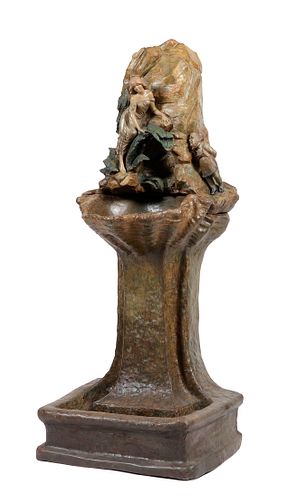Art Nouveau fountain by GOLDSCHEIDER; Vienna, ca. 1895. Polychrome terracotta.
Lot 40
About Seller
Setdart Auction House
Carrer Aragó 346
Barcelona
Spain
Setdart Subastas was born in 2004 and is currently the first online art auction in Spain with solidity, prestige and reliability guaranteed by our more than 60,000 users. Setdart has a young, dynamic and enterprising team ready to successfully manage the purchase and sale of art works through custom...Read more
Categories
Estimate:
EUR€3,000 - EUR€4,000
$3,225.81 - $4,301.08
Absentee vs Live bid
Two ways to bid:
- Leave a max absentee bid and the platform will bid on your behalf up to your maximum bid during the live auction.
- Bid live during the auction and your bids will be submitted real-time to the auctioneer.
Bid Increments
| Price | Bid Increment |
|---|---|
| EUR€0 | EUR€10 |
| EUR€200 | EUR€25 |
| EUR€500 | EUR€50 |
| EUR€1,000 | EUR€100 |
| EUR€3,000 | EUR€200 |
| EUR€5,000 | EUR€500 |
| EUR€10,000 | EUR€1,000 |
| EUR€20,000 | EUR€2,000 |
| EUR€50,000 | EUR€5,000 |
About Auction
By Setdart Auction House
Oct 27, 2021
Set Reminder
2021-10-27 10:00:00
2021-10-27 10:00:00
America/New_York
Bidsquare
Bidsquare : 19th & 20th Century Paintings & Decorative Arts
https://www.bidsquare.com/auctions/setdart-auction-house/19th-20th-century-paintings-decorative-arts-7767
Setdart Auction House sofia@setdart.com
Setdart Auction House sofia@setdart.com
- Lot Description
Art Nouveau fountain by GOLDSCHEIDER; Vienna, ca. 1895. Polychrome terracotta. Measurements: 143 x 61 x 45 cm. Fountain of Art Nouveau style, with a sculptural structure that simulates a natural fountain in which we find the figures of two magical beings, a nymph and a dwarf with a red beard, similar to the Irish leprechauns. The female figure stands out for her sensuality and beauty, a reflection of the Art Nouveau concept of the feminine. The woman is considered in Art Nouveau, influenced by symbolist literature, as a being of transformation and metamorphosis, and therefore is usually reflected with extreme fantasy, being associated with the supernatural and the unknown. The feminine is intimately associated with the hidden part of nature, with the mysterious and therefore attractive and seductive. The fragile woman, with narrow shoulders and stylized figure, like a nymph or sylph attracts man inexorably towards perdition. She is thus conceived as a contradictory figure, exotic and weak in appearance but demonic in essence. The Austrian ceramic and porcelain firm Goldscheider was founded in 1885 by the Bohemian sculptor Friedrich Goldscheider. For more than half a century the firm created masterpieces of historicism, Art Nouveau and Art Deco. The founder was able to attract both acclaimed artists and young innovators to his factory, so that great ceramists of the time, such as W. Bosse, B. Geiger, J. Lorenzl, I. Meisinger and M. Powolny, among others, worked there. After Goldscheider's death, the factory was taken over by his widow Regina, who continued to produce her husband's models, along with new ones created by artists who worked for the firm, such as D. Chiparus during the Art Deco period. Until its closure with the rise of National Socialism, more than four thousand different models were made in the factory, both by Goldscheider himself and other authors. From the beginning, the factory won a multitude of awards, first prizes and gold medals at countless world fairs, exhibitions and trade fairs. Today its pieces are in great demand by collectors from all over the world. They can currently be admired in various museums around the world, such as the Fine Arts Museum of San Francisco, the Metropolitan Museum of Art in New York or the Minneapolis Institute of Arts. In 2007, Goldscheider's pieces were exhibited at the Vienna Museum and, the following year, at the LBI in New York.
- Shipping Info
-
In-house shipping available. Please inquire at admin@setdart.com.
-
- Buyer's Premium



 EUR
EUR CAD
CAD AUD
AUD GBP
GBP MXN
MXN HKD
HKD CNY
CNY MYR
MYR SEK
SEK SGD
SGD CHF
CHF THB
THB















